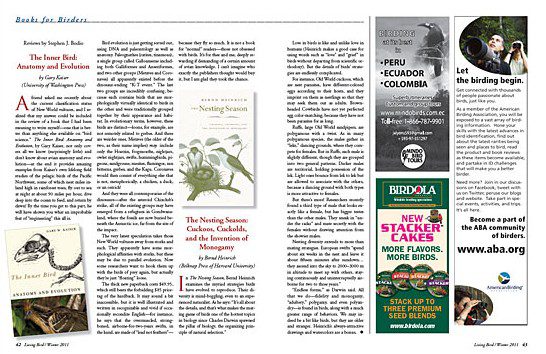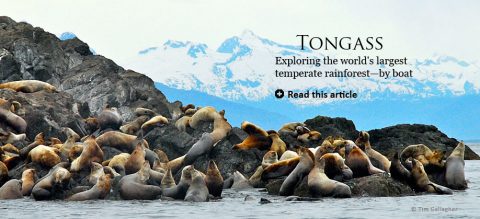Book Review: The Inner Bird: Anatomy and Evolution, by Gary Kaiser
Reviewed by Stephen J. Bodio
January 15, 2011
A friend asked me recently about the current classification status of New World vultures, and I realized that my answer could be included in the review of a book that I had been meaning to write myself—one that is better than anything else available on “bird science.” The Inner Bird: Anatomy and Evolution, by Gary Kaiser, not only covers all we know (surprisingly little) and don’t know about avian anatomy and evolution—at the end it provides amazing examples from Kaiser’s own lifelong field studies of the pelagic birds of the Pacific Northwest, some of which nest miles inland high in rainforest trees, fly out to sea at night at about 90 miles per hour, dive deep into the ocean to feed, and return by dawn! By the time you get to this part, he will have shown you what an improbable feat of “engineering” this all is.
Bird evolution is just getting sorted out, using DNA and paleontology as well as anatomy. Paleognathes (ratites, tinamous), a single group called Galloanserae including both Galliformes and Anseriformes, and two other groups (Metaves and Coronaves) all apparently existed before the dinosaur-ending “K-T event.” The last two groups are incredibly confusing, because each contains birds that are morphologically virtually identical to birds in the other and were traditionally grouped together by their appearance and habitat. In evolutionary terms, however, these birds are distinct—loons, for example, are not remotely related to grebes. And there are weirder ones. Metaves (the older of the two, as their name implies)may include only the Hoatzin, frogmouths, nightjars, owlet nightjars, swifts, hummingbirds, pigeons, sandgrouse, mesites, flamingos, sun bitterns, grebes, and the Kagu. Coronaves would then consist of everything else that is not, metaphorically, a chicken, a duck, or an ostrich!
And they were all contemporaries of the dinosaurs—after the asteroid Chicxulub’s strike, all of the existing groups may have emerged from a refugium in Gondwanaland, where the fossils are now buried beneath the Antarctic ice, far from the site of the impact.
The very latest speculation takes those New World vultures away from storks and such. They apparently have some morphological affinities with storks, but these may be due to parallel evolution. Now some researchers want to hook them up with the birds of prey again, but actually they’re just “floating” loose.
The thick new paperback costs $49.95, which still beats the forbidding $85 price-tag of the hardback. It may sound a bit inaccessible, but it is well illustrated and written in recognizable and vivid if occasionally recondite English—for instance, he says that the overmuscled, strong-boned, airborne-for-two-years swifts, in the hand, are made of “lead not feathers”—because they fly so much. It is not a book for “normal” readers—those not obsessed with birds. It’s for thee and me, deeply rewarding if demanding of a certain amount of avian knowledge. I can’t imagine who exactly the publishers thought would buy it, but I am glad they took the chance.

All About Birds
is a free resource
Available for everyone,
funded by donors like you
American Kestrel by Blair Dudeck / Macaulay Library



